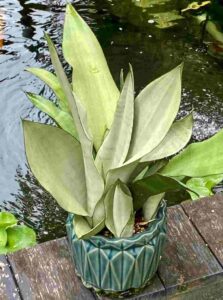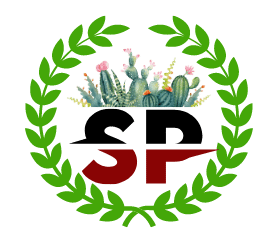Snake plant is one of the most popular, stylish foliage plants grown as house plant and indoor plant possessing many health benefits. It is native to tropical and subtropical regions of Europe, Asia and western Africa. It can be mostly found growing in the highlands of Kenya, Zimbabwe. It is a perennial evergreen plant grown for its foliage beauty with an average lifespan of 5 to 10 years. However, some gardeners have claimed to have had their snake plants last even up to 25 years. It has attractive sword-shaped leaves that grow upright and is grown indoors as well as outdoors.
The size and shape of the plant also depends on its variety. Its height ranges from 6 inches to even 12 feet. It grows best in small pots covering less space. It is a slow grower however it experiences a boost in growth under bright sunlight in summer.
It is a common houseplant. However, varieties like Kirkii Coppertone, Fischeri Singularis, and Green Mermaid are considered rare. It is known by other names like mother-in-law’s tongue, Saint George’s sword, African Bowstring-Hemp, Spear Plant, Bowstring-Hemp, etc. Until 2017, it was known under the synonym Sansevieria trifasciata. It is one of the eight regulated invasive exotic plants. They are grown outdoors in USDA zone 8 through 11 and grown indoors since they become winter hardy in USDA zone 9 to 11. It thrives best in indirect sunlight with airflow and watering can be done once a week. It is highly disease resistant and can tolerate low light, dry conditions as well as season change. But, one should look for root rot in case of water lodging conditions. It’s like a god gift to the gardening lover busy bees because of its low maintenance and minimal care requirement. It can be the best choice for first time gardeners as well.
What is special about this plant is the locals use this plant to treat earache, snake bites and even ulcers. According to the research conducted by NASA, It has been proven as one of the best air purifying plants which absorbs toxins like formaldehyde and benzene. It was also found that snake plants can release oxygen 24 hrs and can increase oxygen level at night. So, it can be kept anywhere near bed as well. It is quite famous among the gardeners due to the availability of a large number of its wild varieties resembling artificial foliage.
In this article, we’ll be discussing some of its varieties you should consider listing as your houseplant in detail.
Botanical Classification
Kingdom: Plantae
Clade: Tracheophytes
Clade: Angiosperms
Clade: Monocots
Order: Asparagales
Family: Asparagaceae
Sub-family: Nolinoideae
Genus: Dracaena
Species: trifasciata
Types Of Snake Plants
There are various types of snake plants. Here, We have mentioned the 31 types with names and images.
1.Mother-in-law’s tongue (Dracaena trifasciata)

This snake plant is the most popular cultivar which can grow 3 feet tall. It has long dark green pointed leaves with a yellow edge. It produces white flowers which grow in tall spikes or stalks.
2. Sansevieria cylindrica (Dracaena angolensis)

It has long leaves rolled into cylindrical shape with dark green alternating horizontal stripes. It only grows upright and can grow 20-24 inches tall.
3. Sansevieria trifasciata ‘Twist’ (Dracaena trifasciata)

As the name suggests, it has pointed leaves twisted at the top. The leaves are variegated with yellow border and dark green horizontal stripes in the middle.
Also Read: 28 Stunning Pink Succulents To Grow
4. Zeylanica (Sansevieria zeylanica)

It has light colored long, sword-shaped leaves with horizontal dark green alternating stripes. The leaves are erect and rigid.
5. Sansevieria Laurentii (Dracaena trifasciata var. laurentii)

Also called silver queen. Its leaves are bordered with yellow colour along the edge and have dark green zigzag stripes inside it. It grows more than 1 metre tall.
6. Sansevieria Futura superba (Dracaena trifasciata var. Futura superba)

This types of snake plants has narrow leaves with a wide yellowish border on the entire leaf. It always remains less than 2 feet.
7. Sansevieria Futura simplex (Dracaena trifasciata var. Futura simplex)

It has wide leaves and a thinner greenish yellow border than superba. The green part in the middle is wider and darker. It also doesn’t grow above 2 feet.
8. Sansevieria Futura Robusta (Dracaena trifasciata var. Futura robusta)

It has silvery green foliage with dark green stripes without a yellow border. Its short and wide leaves are easy to maintain.
Read More: 20+ Large Succulents Which Looks Stunning
9. Sansevieria Moonshine (Dracaena trifasciata var. Moonshine)

It has a uniform light green silvery colour as if the moon shines on it. It is easy to identify due to its single colour and can grow more than 2 feet tall.
10. Sansevieria Bantel’s sensation (Dracaena trifasciata var. Bantel’s sensation)

It is one of the unique types of snake plants also called sansevieria white. It has very beautiful long narrow leaves. It has white vertical lines along the border mixed with faint yellow stripes in the centre.
11. Sansevieria masoniana (Dracaena masoniana)

It is also known as whale fin. It has plain green wide leaves without any border and barely visible green stripes.It has two types. One that grows wider and bigger whereas another is called masoniana dwarf which always remains small.
12. Sansevieria Black dragon (Dracaena trifasciata var. Black dragon)

Also called black robusto. It has dark green coloured leaves without any variegation. It remains below 2 feet.
13. Sansevieria Black star (Dracaena trifasciata var. Black star)

Also known as black gold. It is similar to black dragon in shape but the leaves are variegated with yellow colour and the dark green in the middle is also surrounded by yellow outlines on the edges.
14. Sansevieria gracilis (Dracaena trifasciata var. Gracilis)

It is similar to cylindrica variety in shape but the growing pattern is different.It has pointed leaves rolled inside trailing like grass consuming large space. It forms rosettes of upto twelve conical light green leaves arranged spirally.
15. Sansevieria Mini Boncel (Dracaena trifasciata var. Mini)

It is a very small cultivar with wide short leaves highly curved from both edges resembling a small rosette of plump leaves.
16. Sansevieria Desertii (Dracaena desertii)

Also called Rhino grass. This cultivar has succulent leaves pointing in upward direction. It has a red tint on its surface and can grow 20-24 inches tall.
17. Hahnii (Dracaena trifasciata var. hahnii)

It is a small cultivar with dark green broad leaves pointed at the top with some light green stripe giving a rosette appearance.
18. Golden Hahnii (Dracaena trifasciata var.‘Golden Hahnii’)

It is a dwarf variety less than 2 feet tall and has a rosette appearance. The leaves have lots of yellow and green colour combinations with dark green edges along with some silver margins in the centre.
19. Sansevieria Robusta (Dracaena Robusta)

This is a taller variety of hahnii which can grow upto 1 feet and has longer leaves. It is also called the cousin of Zeylanica.
20. Sansevieria patens (Dracaena patens)

It is a dwarf cultivar rosette in appearance. It has plain green leaves with some dark vertical lines.
21. Sansevieria ballyi: Dracaena ballyi

It is a dwarf variety having dark green leaves with light green zigzag stripes slightly curved along the edges. It produces white flowers along the spike on blooming.
22. Sansevieria fischeri: Dracaena fischeri

It is a dwarf cultivar with dark green leaves ringed with faint zigzag stripes. It produces clusters of white flowers blooming in summer.
23. Sansevieria bacularis ‘Mikado’: Dracaena bacularis ‘Mikado’

The leaves are long, narrow and pointed spreaded upward without other variegation.
24. Sansevieria Ehrenbergii: Dracaena hanningtonii

The leaves are stacked upon each other and have a touch of copper hue at the edges.
25. Sansevieria Cleopatra: Dracaena cleopatra

It has curled brown edged leaves with some intricate vertical dark green lines.
26. Sansevieria francisii: Dracaena francisii

It is a hardy plant with densely packed rows of leaves forming stolon.It grows strikingly.
27. Sansevieria hyacinthoides: Dracaena hyacinthoides

Also known as African bowstring hemp. It is a shade-tolerant flowering cultivar with slightly brown-tinted edges grown for medicinal and spiritual benefits.
28. Sansevieria parva ‘Kenya hyacinth’: Dracaena parva

It has long light green pointed leaves with some dark green stripes. It produces some pleasant smelling fragrant white flowers like hyacinth.
29. Sansevieria eilensis: Dracaena eilensis

This is a small cultivar with purplish-blue colour along the edges. It is drought resistant and produces spiky flowers.
30. Sansevieria canaliculata: Dracaena canaliculata

It has round leaves growing upright which gets slightly curved along the top. It is a non-drought tolerant cultivar preferred indoors which can grow 3-4 feet tall.
31. Star sansevieria: Dracaena pethera ‘Kirkii’

Also called pangane sansevieria. It has dark green foliage spreaded around resembling taller forms of grasses possessing unique, fluorescent green patterns.
Conclusion
Thus, These were the best types of snake plants that you can grow. The snake plant filters indoor air, removes toxic pollutants, boosts mental health, relieves minor physical ailments, is effective against allergies and most importantly, is low-maintenance and easy to take care of. It has a unique feature to convert carbon dioxide to oxygen at night. These benefits make this plant an easy option among the houseplants. It can regulate healthy airflow which makes it an ideal plant for bedroom decor. Its wide number of attractive varieties are even attractive and grab every attention when kept as house decor. No extra care is required to grow this plant. Further, it can be easily propagated. You can blindly trust this plant and go for its purchase even if you’re a beginner. So, when are you gonna grab yours?

